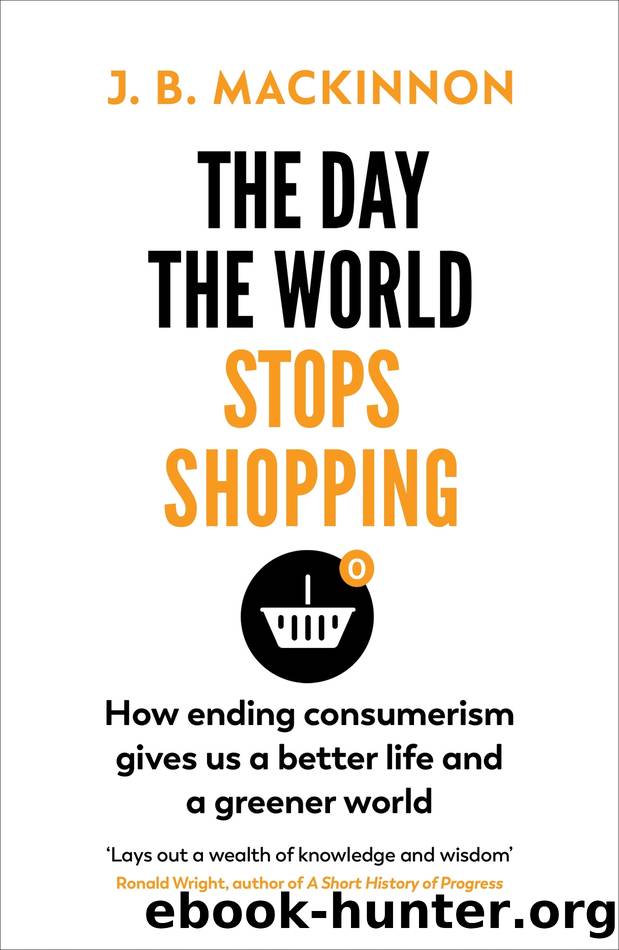The Day the World Stops Shopping by J. B. MacKinnon

Author:J. B. MacKinnon [MacKinnon, J. B.]
Language: eng
Format: epub
ISBN: 9781473560567
Publisher: Random House
Published: 2021-05-14T00:00:00+00:00
13.
Business Plays the Long, Long, Long, Long Game
There is a business concept called the âfour moresâ that could stand as the motto of modern consumer capitalism. Because it sounds greedy and underhanded, however, itâs rarely mentioned outside business schools. The four mores are as follows: sell more things, to more people, more often, for more money. To do so is to achieve the ultimate in perpetual profits, sales and growth.
Mitsuharu Kurokawa was puzzled by notions like these when he moved from Japan to the US to complete a business degree. He remembers a scenario posited by one of his professors there. Suppose a customer wanted seven hundred units of your companyâs product, but your factory was designed to make batches of five hundred. What would you do? The correct answer, his professor said, was to make one thousand units, provided a profit could still be made if seven hundred units were delivered to the customer and three hundred scrapped as waste.
âI just donât think it makes sense, is what I was thinking,â Kurokawa told me, sipping a cup of matcha. âWe never try to overproduce. We also try not to underproduce. We try to be very efficient.â
Kurokawaâs perspective on business takes an unusually long view. Currently in his thirties, he is in line, as his fatherâs only son, to become the eighteenth member of his family to lead Toraya, a Japanese confectionery company. The firm has existed since at least the 1600s, making it about 420 years old. Toraya is a tortoise in a world of fruit flies, Methuselah among the tweens. The average lifespan of even the biggest companies on the stock market has fallen from sixty-seven years in the 1920s to fifteen years today. The average for businesses as a whole is now just ten years.
Almost every company likes to believe that their brand is beloved enough and strong enough to survive the end of shoppingâthat their particular business is made to last. Torayaâs claim is more credible. When the coronavirus struck in 2020, it was only the latest in a list of storms the company has weathered. Toraya burned down to its signboard in 1788, when a fire razed nearly fifteen hundred city blocks in Kyoto, which was then Japanâs capital. Later came the two-year period when the Japanese royal familyâTorayaâs best customer, at times accounting for half of their salesâfell on hard times and failed to pay their bills. When Japanâs capital shifted to Tokyo in 1869, Toraya shifted its headquarters as well (in an age before motorized transport), and then moved six more times as Tokyo expanded to become the worldâs largest city. Toraya survived the 1923 Great Kanto Earthquake, which also spawned a tsunami, a blaze that devoured nearly half the city, and a hellish fire tornado as tall as a twenty-storey building. One hundred and forty thousand people died, but the quake did not stop Toraya from launching a delivery service the following year. Then their factory was devastated during the American incendiary
Download
This site does not store any files on its server. We only index and link to content provided by other sites. Please contact the content providers to delete copyright contents if any and email us, we'll remove relevant links or contents immediately.
International Integration of the Brazilian Economy by Elias C. Grivoyannis(91219)
The Radium Girls by Kate Moore(11921)
Turbulence by E. J. Noyes(7936)
Nudge - Improving Decisions about Health, Wealth, and Happiness by Thaler Sunstein(7615)
The Black Swan by Nassim Nicholas Taleb(7010)
Rich Dad Poor Dad by Robert T. Kiyosaki(6403)
Pioneering Portfolio Management by David F. Swensen(6226)
Man-made Catastrophes and Risk Information Concealment by Dmitry Chernov & Didier Sornette(5921)
Zero to One by Peter Thiel(5686)
Secrecy World by Jake Bernstein(4646)
Millionaire: The Philanderer, Gambler, and Duelist Who Invented Modern Finance by Janet Gleeson(4376)
The Age of Surveillance Capitalism by Shoshana Zuboff(4210)
Skin in the Game by Nassim Nicholas Taleb(4162)
Bullshit Jobs by David Graeber(4095)
The Money Culture by Michael Lewis(4076)
Skin in the Game: Hidden Asymmetries in Daily Life by Nassim Nicholas Taleb(3929)
The Dhandho Investor by Mohnish Pabrai(3699)
The Wisdom of Finance by Mihir Desai(3654)
Blockchain Basics by Daniel Drescher(3507)
